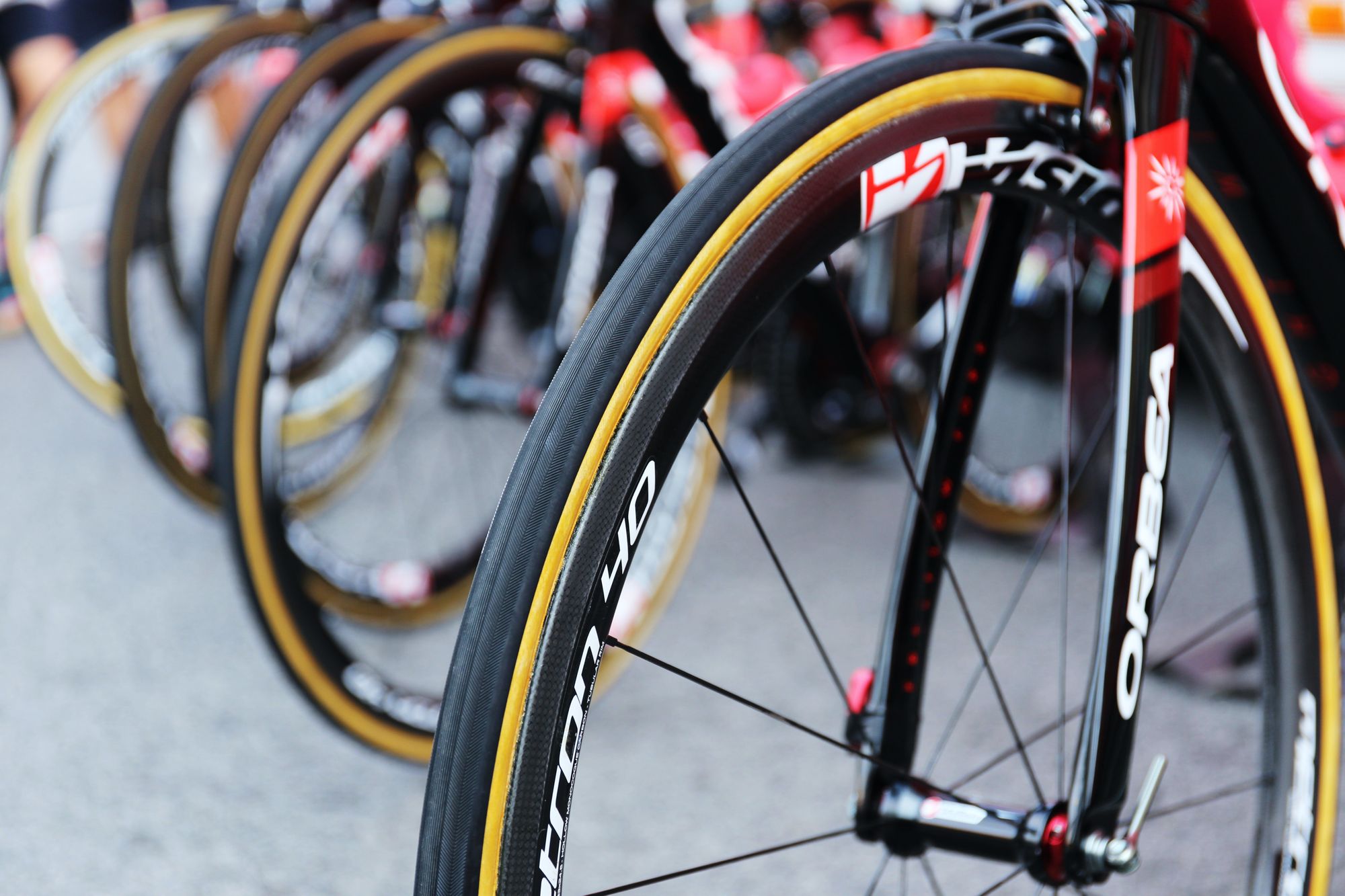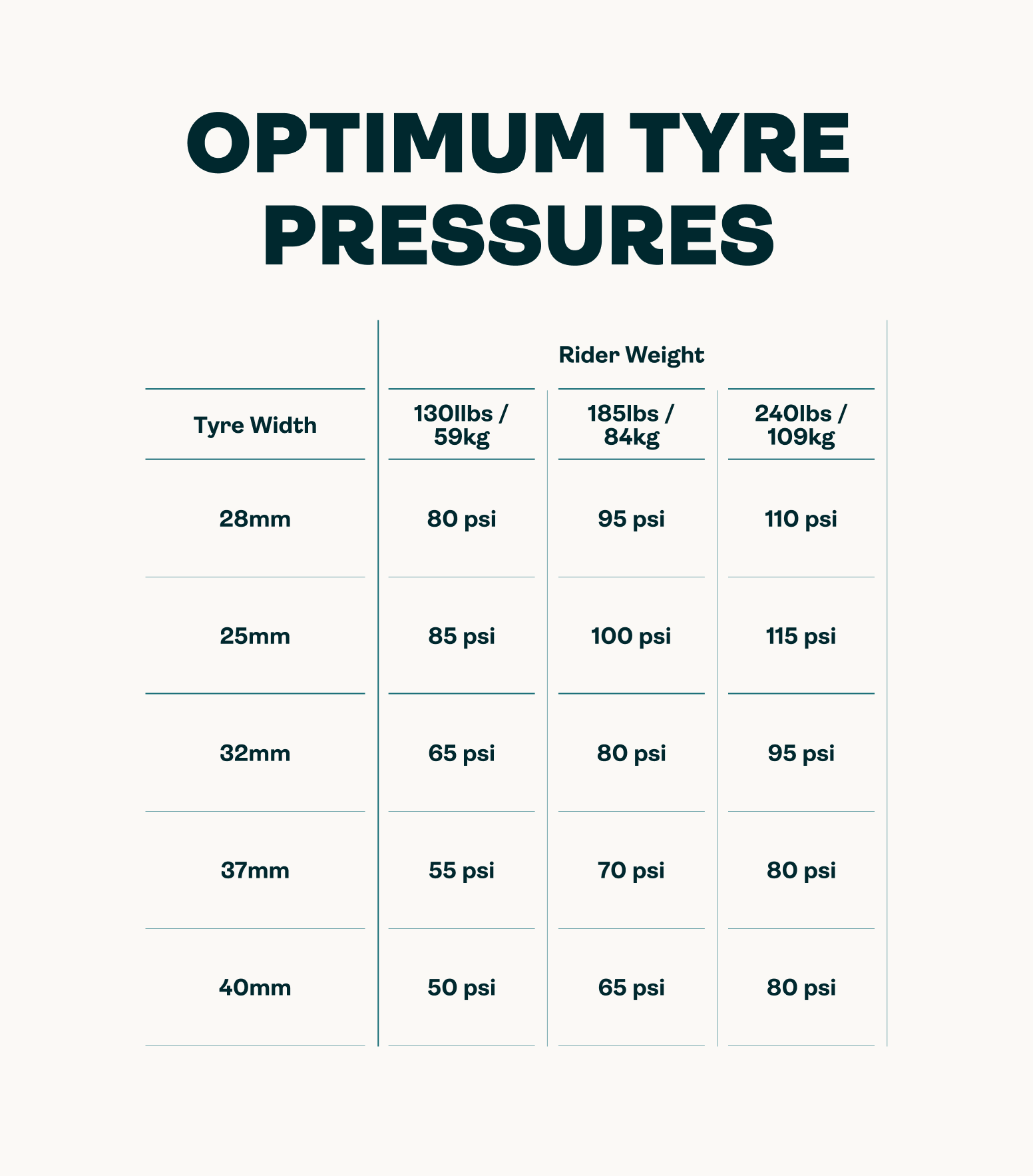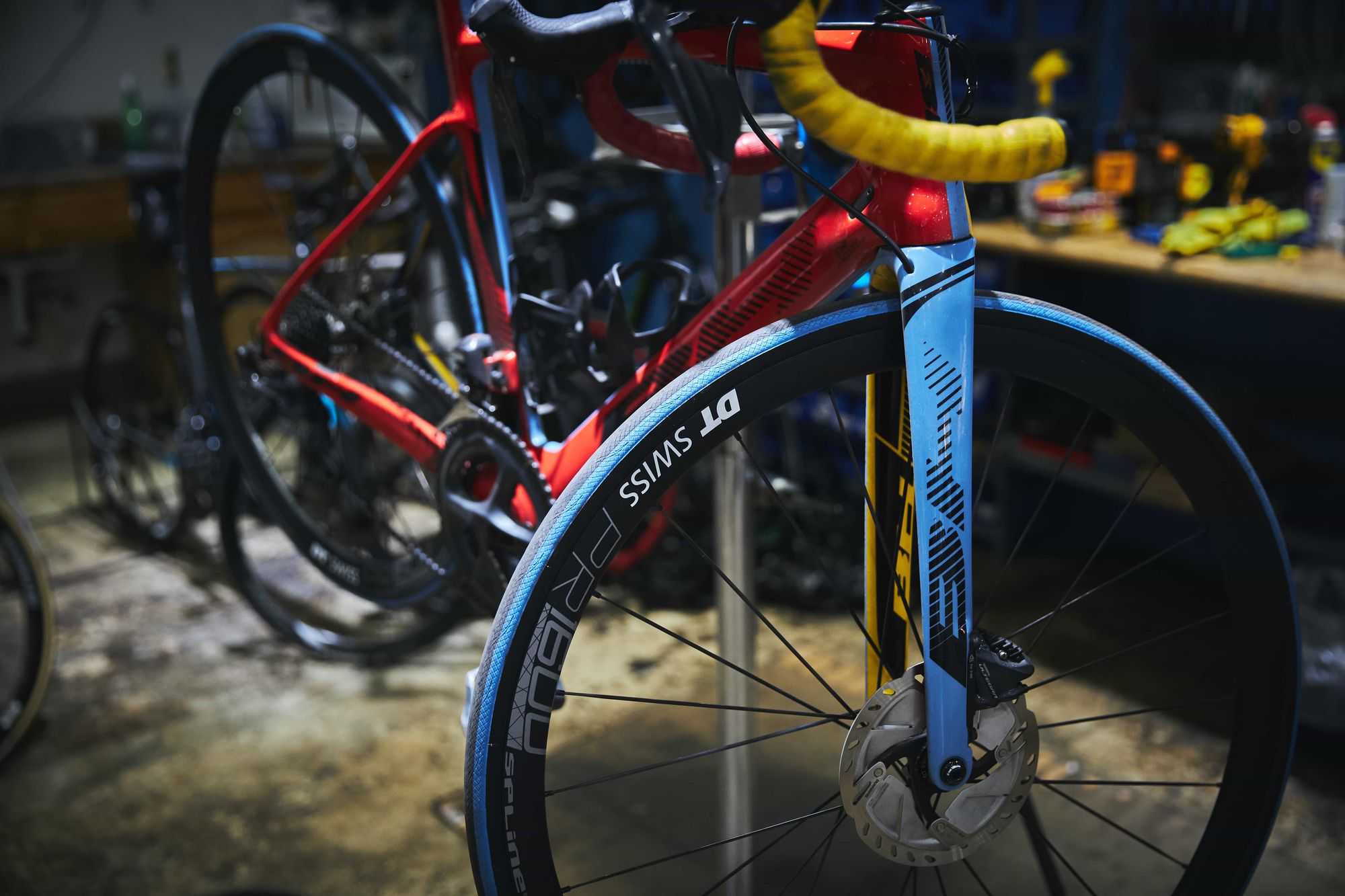We’ve put together this guide to tell you everything you need to know about bicycle tyre sizes.
Grab a coffee; this could take a while. We’ll take you on a journey through the wonderful world of bike tyre sizes. Stick with us to learn all about:
- Bicycle tyre sizes
- Tyre width
- Rim compatibility
- Tread, compound, and puncture protection
- Types of bike tyres
- Inner tubes
- Optimum cycle tyre pressures
After we’re done, you’ll know everything you need to know about cycle tyres.
Bike tyre sizes
Sooner or later, you’ll need to replace your bike’s tyres, so how do you know what size and type you need? Well, you could get the same as the old ones. But what if you can’t get hold of them or fancy a change? What do you do then?
The first thing to do is check the markings on your tyre. Of course, it’s not going to be quite that simple because the markings have the potential to confuse.
You see, there are three main types of tyre measurement: British/American, French, and ISO European Tyre and Rim Technical Organisation (ETRTO). The first is imperial, the second metric, and the ETRTO attempts to give a standardised approach.
1. British/American (Inches) - Diameter x width
What is it?
(Approx. diameter of tyre) x (approx. width of tyre when inflated)
Example: 29x2.2” or 26x2.0”
Rules for replacing tyres: Diameter of tyre and wheel must match. Tyre width depends on what your wheel rims and frame can support.
Bike types: Usually mountain bikes, children’s bikes, and some hybrid bikes. Tyres marked with fraction instead of decimal are not compatible.
2. French (mm) - Diameter x width
What is it?: (Approx. diameter of tyre) x (approx. width of tyre when deflated)
Example: 700x23c or 700x45c
Rules for replacing tyres: Diameter of tyre and wheel must match. Tyre width depends on what your wheel rims and frame can support.
Bike types: Most common for road and some hybrid bike tyres.
3) ISO/ETRTO (mm) - Width - diameter
What is it?: (Approx. width of tyre when inflated) – (exact diameter)
Example: 23–622 or 50–559
Rules for replacing tyres: Diameter of tyre and wheel must match. Tyre width depends on what your wheel rims and frame can support
Bike types: Most tyres have this marking as its used by manufacturers. Most tyres use the ETRTO system, but tyres can come with several different markings. If you see:
- 28x15/8x13/8 (imperial), 28x1.4 (metric), and 700x35c (French); they are the same as 37-622

Is your brain hurting yet?
Even worse, the same or similar markings can sometimes be found on completely different sizes of tyres: e.g., 26×1½ and 26x1.5. You would assume these are both 26” in diameter and one and a half inches in width. Well, they’re not. In fact, 26×1½ is a whole inch bigger than 26×1.5 because the former is ‘fractional’ and the latter ‘decimal.’
To show you how these different measurements work, we found this helpful diagram on Wikipedia, which helps make sense of the madness.
What width tyre should I use?
The width of the tyre you decide on comes down to personal preference.
Roadies tend to go for narrow tyres to reduce weight and improve aerodynamics. Old school riders tended to opt for 23mm, but since the pros in the peloton started using wider tyres, 25mm is becoming a more common choice. You’ll even find some of the latest race bikes can accommodate tyres that are 30mm.
For those who prefer sportives and endurance riding, wider tyres are usually the preferred option, with 28mm a common standard because comfort tends to be a higher priority than speed.
If you’re a commuter on a road bike, you could look at a tyre 28mm width if you also have room for mudguards. But again, it will depend on your make of bike. And if you commute on a mountain bike, you can probably look at up to 44mm tyres.
What about rim compatibility?
You would have thought that if the tyre and rim ISO/ETRTO diameters match, the tyre will go on the rim. Well, you thought wrong.
Basically, a thin rim needs a narrow tyre, and a wide tyre needs a wide rim. The ideal ratio is about 1.8:1.
So, that means a 23mm tyre is ideal for a 13mm rim (13×1.8=23.4).
If maths is not your strong point, check out this handy chart on the Schwalbe website.
You must also remember that your tyre and wheel size is also going to be limited by the space that’s available in your bike’s frame, fork, and mudguards.
Top tips:
- ISO/ETRTO tyre diameters are reliable, but widths may vary. To find a
tyre’s exact width, use a Vernier calliper to measure it. - Tubeless tyres need wider rims, so the ratio may be different from 1.8:1.
- Tubeless rims and tyres are tight fitting. If you want to go tubeless, both
your tyre and rim need to be tubeless ready.
Let’s talk tread, tyre compound and puncture protection
Now it’s time to turn our attention to tread, tyre compound and punctures.
Tyre tread
The pattern you see on the top of your tyre is its tread. It’s designed to affect the tyre’s performance in terms of steering precision, grip, and water displacement.
Most road tyres are slicks or come with a smooth design because it helps reduce rolling resistance and increases grip on smooth surfaces so you can corner at speed. That’s great for the summer months, but for winter, you might want to look at grooved tyres (like the Specialized All Condition Armadillo tyres – other brands are available) which help displace or dispel water to prevent you from losing traction, slipping and potential road-rash.
Tyre compound
The compound refers to the quality of the rubber that’s used—the softer the compound, the better the grip, but the faster the wear. As you would expect, harder compounds give better wear but less grip.
Puncture protection
Punctures are the bane of a cyclist’s life. Many tyres have a layer under the tread to help prevent punctures. It’s always a toss-up between the benefit of puncture protection versus the extra weight.
What are the different types of bike tyres?
At the start, we said that buying cycle tyres isn’t as easy as it sounds. After you’ve worked out the size, compound, and tread, your next decision is what type of bike tyre do you want.
You have a choice of three:
- Clincher
- Tubular (aka tubie or tub)
- Tubeless
Your choice of wheels/rims dictates the type of tyre you use. A tubular tyre can’t be mounted on a clincher rim. A clincher tyre can’t be fitted to tubular rims. And although a tubeless tyre can be fitted to a clincher rim, it can only be inflated with an inner tube.
Clincher
These are the most common and need an inner tube. If you puncture, simply change (or patch) the inner tube. They have either a wire or Kevlar fibre bead, which hooks underneath the ridges of a wheel rim to hold the tyre in place.
Tubeless
These have been a staple of mountain biking and cyclocross for a long time but are now growing in popularity with roadies too. As the name suggests, they don’t need an inner tube instead, the tyre hooks tightly onto the wheel to create an airtight seal. Sealant is pumped into the tyre, plugging small holes and splits, reducing the chance of flats.
Because they can run at lower pressures than clinchers, they offer better rolling resistance giving you a more comfortable ride and better traction. However, you will need a compatible wheelset.
Tubular
These are loved by pros but not so much with everyday riders because they’re expensive and a complete pain.
Tubular tyres still use inner tubes, but they’re sewn into the tyre rather than sitting separately. Therefore, they must be stuck to the wheel using glue or special tape.
On the plus side, you benefit from significant weight savings and better ride quality, but a major downer is that you can’t just change the inner tube when you get a puncture.
What about inner tubes?
If you run clincher tyres, you’re going to need inner tubes.
Guess what? There’s more than one type – what a surprise!
You’ve already learnt about the different cycle tyre sizes; well, the inner tubes you buy must be the right size according to the diameter and width of your tyre.
The size you need is almost always printed on the sidewall of your tyre. The inner tubes usually show the wheel diameter and width range they fit – for example, 26 x 1.95-2.125 means the inner tube will fit a 26” tyre with a width of between 1.95” and 2.125”.
Of course, it’s not going to be quite that easy; you must also consider the type and length of valve you need.
There are two main types of valves:
1. Schrader Valves
What do they look like?
They are the same valves used on all motor vehicle tyres (often referred to as ‘car type’ valves).
How do they work?
They have a spring-loaded core (which keeps the valve closed). The central pin can be depressed with a narrow object to release air from the tube.
Which bikes use them?
Low-pressure tyres such as kid’s bikes and mountain bikes.
2. Presta Valves
What do they look like?
These have a slim stem and are often threaded to accept a locking ring, which holds it tight to the rim.
How do they work?
Unscrew the top section, which allows the core of the valve to be free to open and close. It’s a high-pressure value so the air pressure shuts the valve and the screwing shut of the top section that keeps it shut.
Which bikes use them?
High-pressure tyres such as road bikes.
What about valve length?
If you use deep section rims, you’ll need a longer valve (a long valve can be between 60-80mm, whereas a standard is 40mm).
Optimum tyre pressures
You’ll be pleased to hear we’ve nearly completed your bicycle tyre education. The final hurdle is tyre pressure.
Did you know that the pressure you run your tyres at affects how your bike rides? Getting the pressure right will help you strike the perfect balance between cushioning, rolling speed, and puncture protection.
As a rule, the higher the pressure, the fewer punctures you’ll get, and you’ll get less rolling resistance. But lower pressure will give more comfort.
Before you rush off and pump your tyres up to the max, your perfect tyre pressure depends not only on the tyres you use but also on your weight. Put simply, heavier riders need higher pressures, whereas lighter riders need less.
To give you a head’s up, here’s a table for you.

Of course, this is only a guide. The pressure you use will also come down to preference and the terrain on which you’re riding, but it’s a good start to get you in the right ballpark.
Congratulations! You are now a bicycle tyre aficionado
You made it, and your coffee has now probably gone cold, but by sticking with us, you now know everything you need to know about bicycle tyres. Now you can go away and impress your mates with your newfound knowledge when out on the pedals.
Laka’s got your back when it comes to specialist bike insurance.
We’re here to keep you on the road no matter what life throws at you.

